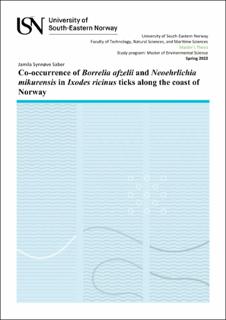| dc.description.abstract | Borrelia afzelii (B. afzelii) and Neoehrlichia mikurensis (N. mikurensis) are the two most common tick-borne pathogens found in Ixodes ricinus ticks (I. ricinus) in Norway. A previous study by Pedersen et al. (2019) found a high prevalence of N. mikurensis in I. ricinus ticks collected in Norway’s southern and northwestern coastal parts. However, the pathogen was almost absent along the southwest coast. Also, co-infections with B. afzelii and N. mikurensis in I. ricinus ticks have been higher than expected by random chance. This master thesis raises whether the low prevalence of N. mikurensis along the southwest coast is paralleled with a low prevalence of B. afzelii. The study’s first aim was to investigate the prevalence of B. afzelii in I. ricinus ticks along the Norwegian coast. The second aim was to compare the prevalence of B. afzelii with that of N. mikurensis and investigate whether they co-occur. The ticks of this study had previously been collected from 10 locations along the coast of Norway, from Spjærøy (59.1°N 10.9°E) in the southeast to Brønnøysund (65.4°N 12.1°E) in the northwest. Samples of 185 individual adult ticks and 671 nymph pools were analyzed for B. afzelii with real-time PCR. The total prevalence of B. afzelii in adult ticks was 15%, and the total estimated pooled prevalence in nymphs was 11.4%. The prevalence was the highest in the most southern and northern locations. The locations in-between were described as a low prevalence area. This study suggested that the difference in the prevalence of B. afzelii was due to climate, seasonal variation, the availability, and compatibility of vertebrate hosts. B. afzelii in N. mikurensis in I. ricinus ticks co-occurred at seven out of 10 locations. The prevalence of both pathogens was the highest in the southernmost and northernmost locations and lower at the locations in-between, along the southwest coast. This study suggested that their co-occurrence was due to the availability of common reservoir hosts such as bank voles and field mice. The lower prevalence along the southwest coast might have been due to absence, less availability of reservoir hosts or climate. However, B. afzelii in ticks was present at locations in the southwest where N. mikurensis was absent. B. afzelii may therefore have a broader spectrum of reservoir hosts than N. mikurensis, which was suggested to be the common shrew. This is the first study to investigate the co-occurrence of B. afzelii and N. mikurensis in I. ricinus ticks at such geographical scale. | |
